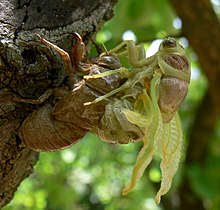Chitin



Chitin (
It is also synthesised by at least some fish and lissamphibians.[4] Commercially, chitin is extracted from the shells of crabs, shrimps, shellfish and lobsters, which are major by-products of the seafood industry.[2][3] The structure of chitin is comparable to cellulose, forming crystalline nanofibrils or whiskers. It is functionally comparable to the protein keratin. Chitin has proved useful for several medicinal, industrial and biotechnological purposes.[3][5]Etymology
The English word "chitin" comes from the French word chitine, which was derived in 1821 from the Greek word χιτών (khitōn) meaning covering.[6]
A similar word, "chiton", refers to a marine animal with a protective shell.
Chemistry, physical properties and biological function

The structure of chitin was determined by Albert Hofmann in 1929. Hofmann hydrolyzed chitin using a crude preparation of the enzyme chitinase, which he obtained from the snail Helix pomatia.[7][8][9]
Chitin is a modified

In its pure, unmodified form, chitin is translucent, pliable, resilient, and quite tough. In most
In butterfly wing scales, chitin is organized into stacks of
Humans and other mammals
Humans and other mammals have chitinase and chitinase-like proteins that can degrade chitin; they also possess several immune receptors that can recognize chitin and its degradation products, initiating an immune response.[19]
Chitin is sensed mostly in the lungs or
Plants
Plants also have receptors that can cause a response to chitin, namely chitin elicitor receptor kinase 1 and chitin elicitor-binding protein.[19] The first chitin receptor was cloned in 2006.[20] When the receptors are activated by chitin, genes related to plant defense are expressed, and jasmonate hormones are activated, which in turn activate systemic defenses.[21] Commensal fungi have ways to interact with the host immune response that, as of 2016[update], were not well understood.[20]
Some pathogens produce chitin-binding proteins that mask the chitin they shed from these receptors.[21][22] Zymoseptoria tritici is an example of a fungal pathogen that has such blocking proteins; it is a major pest in wheat crops.[23]
Fossil record
Chitin was probably present in the exoskeletons of Cambrian arthropods such as trilobites. The oldest preserved chitin dates to the Oligocene, about 25 million years ago, consisting of a beetle encased in amber.[24]
Uses
Agriculture
Chitin is a good inducer of plant defense mechanisms for controlling diseases.[25] It has potential for use as a soil fertilizer or conditioner to improve fertility and plant resilience that may enhance crop yields.[26][27]
Industrial
Chitin is used in many industrial processes. Examples of the potential uses of chemically modified chitin in food processing include the formation of edible films and as an additive to thicken and stabilize foods and food emulsions.[28][29] Processes to size and strengthen paper employ chitin and chitosan.[30][31]
Research
How chitin interacts with the
Chitin and chitosan are under development as
Chitin has been proposed for use in building structures, tools, and other solid objects from a
See also
References
- ISBN 978-1-4641-2611-6.)
{{cite book}}: CS1 maint: multiple names: authors list (link - ^ S2CID 254041961.
- ^ PMID 38043653.
- PMID 25772447.
- ISSN 1610-3661.
- ^ Odier, Auguste (1823). "Mémoire sur la composition chimique des parties cornées des insectes" [Memoir on the chemical composition of the horny parts of insects]. Mémoires de la Société d'Histoire Naturelle de Paris (in French). 1. presented: 1821: 29–42.
la Chitine (c'est ainsi que je nomme cette substance de chiton, χιτον, enveloppe… [chitine (it is thus that I name this substance from chiton, χιτον, covering)]"
- ^ Hofmann, A. (1929). Über den enzymatischen Abbau des Chitins und Chitosans [On the enzymatic degradation of chitin and chitosan] (Thesis). Zurich, Switzerland: University of Zurich.
- .
- doi:10.2533/chimia.2008.444. Archived from the original(PDF) on 2013-06-16. Retrieved 2013-04-14.
- ISBN 0-8053-1957-3
- ISBN 978-0-12-375136-2.
- ^ PMID 20547870.
- ^ Dasi Espuig M (16 August 2014). "Beetles' whiteness understood". BBC News: Science and Environment. Retrieved 15 November 2014.
- PMID 25123449.
- S2CID 86452110.
- ^ PMID 28223133.
- PMID 11710189.
- ISBN 978-0-08-102491-1, retrieved 2023-12-18
- ^ PMID 28251581.
- ^ PMID 25725011.
- ^ .
- PMID 27329426.
- ^ PMID 27148331.
- PMC 1692454.
- PMID 20479963.
- PMID 27148242.
- S2CID 32594901.
- ISSN 0268-005X.
- .
- ISSN 0888-5885.
- S2CID 96578009.
- S2CID 15221318.
- S2CID 104427459.
- S2CID 244341955, retrieved 2022-12-19
- PMID 26287217.
- ISBN 9780080552941.
- ^ "Harvard researchers develop bioplastic made from shrimp shells". Fox News. 16 May 2014. Retrieved 24 May 2014.
- PMID 25393598.
- PMID 32936806.
